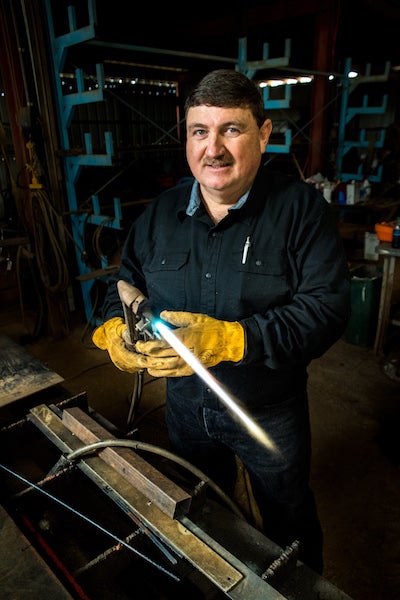
By JOYANNA LOVE/ Editor
Problem solving is at the heart of every project Mark Jones undertakes.
His welding projects have helped cities, farmers and various industries.
“I love a challenge,” Jones said. “A lot of times it’s problem solving. I do a lot of work for farmers.”
Peach racks and rakes and creating tools farmers dreamed up is only a portion of the projects he has tackled.
The giant rake goes on the front of a farmer’s tractor and moves limbs out of the way, while the farmer is trimming the peach tree branches.
Jones originally trained as a cabinet maker at LeCroy Career Technical Center. When he began looking for a job, he wound up on a dairy farm.
This was not Jones’s first experiences working with animals. Jones had been involved in 4-H from elementary through high school and had shown steers in FFA.
After working on the dairy farm for a while, Jones began looking for other, better paying opportunities.
He attended farrier college was in Oklahoma and had his first experience of leaving Alabama.
“It was a unique experience,” Jones said.
After completing the farrier program, Jones worked making horse shoes in Chilton County. He said there were not enough horses in Chilton County to keep business up, so he continued projects with wood to supplement his income.
Later when he was 19 years old, he went to work at a fabrication shop in Pelham.
“You kind of know your calling when you are around it just a little bit,” Jones said.
“I said, ‘I enjoy woodworking, but man this metal is cool and I just got so intrigued in it in just no time.”
After working there for a few months, Jones was sure that working with metal was what he wanted to do for the rest of his life with the goal of owning his own shop.
Many of Jones’ co-workers were quite a bit older than him and showed him the traditional way to do things, such as rolling metal with a pipe and a hammer.
Some of the skills Jones learned while studying cabinet making easily translated to metal work, such as being able to read drawings for a planned project. This helped him to achieve a lead position within two years.
“I was always good at math, loved that, so it transferred,” Jones said.
Geometry was important to both fields.
About 13 years later, Jones opened his own shop in 1996. He has expanded the building several times over the years to allow him to do larger projects.
Welding techniques have changed quite a bit, and the tools used are always becoming more advanced Jones said.
“The cutting torch, for instance, has been kind of replaced by the plasma cutter,” Jones said.
He said the first plasma cutters were large and bulky, now the tools are much smaller and easier to use.
“I enjoyed about 90 percent of everything I’ve made,” Jones said.
Anytime someone says he cannot do something, it becomes a challenge to him to make it happen.
Many of his customers come from word-of-mouth as previous customers talk about the projects he did for them.
“I have clients that have been loyal to me over the years,” Jones said.
He said he has done a lot of commercial work. Some these projects have barely fit in his shop.
“I made some upgrades to some of my equipment,” Jones said. “When I was a kid, my momma said I was always taking a clock or something apart to make it better.”
Some projects required creating a crane system for holding the pieces in place.
He has done work for city of Hoover, churches, Westinghouse, government agencies and the Prattville golf course. At one point, he was purchasing 100,000 pounds of steel a week.
Other projects are significantly smaller, like the metal brackets he makes for a Cyprus garage builder.
He has also built unique items for individuals. some of these include a pig roaster, a fabricated tree stand.
“He was wanting it for Christmas instead of a turkey and all he wanted to roast a pig and show his grandkids,” Jones said.
The fabricated tree stand connects to the back of an all-terrain vehicle allowing a hunter to have an elevated spot to hunt even in a field.
“They laughed at me — until I killed that big buck,” Jones said.
Making sure the customer is happy is always the goal, he said
Each project starts as an idea or a photo brought to him by a potential customer. From there, Jones begins to make sketches and his design drawings.
Now that he has been in the business for a while, a lot of what he used to draw out on paper for dimensions is all in his head.
Jones has also worked with local students who are interested in the trade through internship opportunities.
He does make sketches of the project, but not as detailed as he used to.
